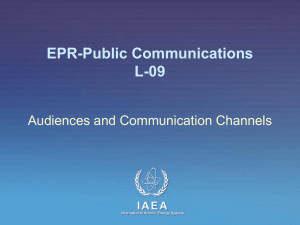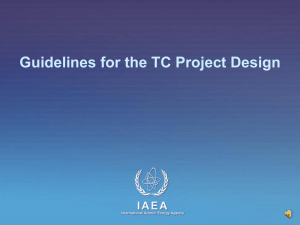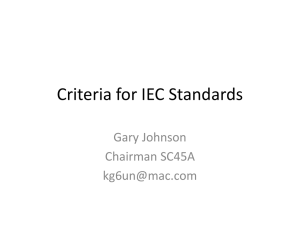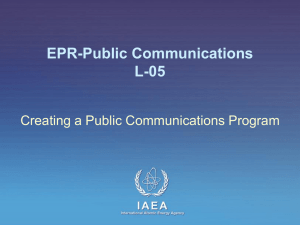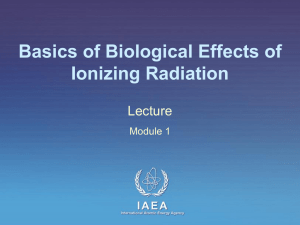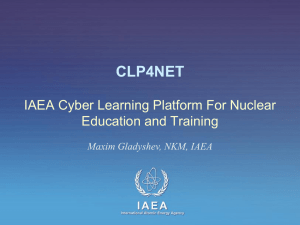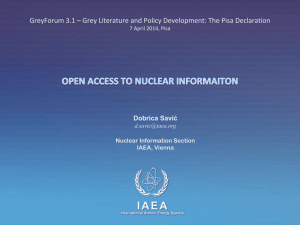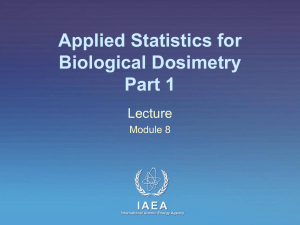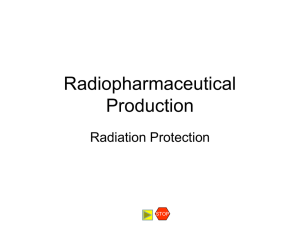Radiation Safety in MS as enabling factor for Technical Cooperation
advertisement
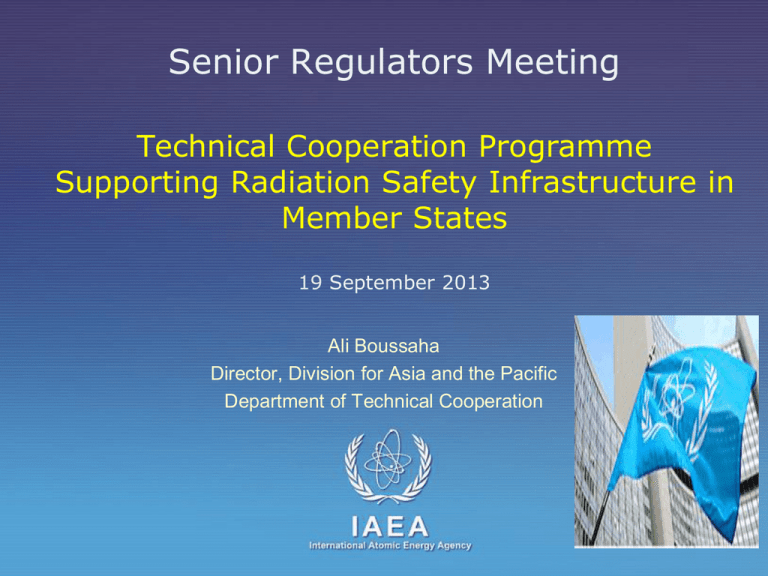
Senior Regulators Meeting Technical Cooperation Programme Supporting Radiation Safety Infrastructure in Member States 19 September 2013 Ali Boussaha Director, Division for Asia and the Pacific Department of Technical Cooperation IAEA International Atomic Energy Agency IAEA TC’s Main Programme Areas Significance of IAEA Technology Transfer Human Health Food and Agriculture Water and Environment Industrial Applications Sustainable Energy Safety and Security IAEA IAEA Statute • Art. III.A.6. The Agency is authorized (...) to establish or adopt, (…), standards of safety for protection of health and minimization of danger to life and property …; and to provide for the application of these standards, (…) to operations under any bilateral or multilateral arrangements… • A. With respect to any Agency project, … the Agency shall have the following rights and responsibilities …: • XII.A.2. To require the observance of any health and safety measures prescribed by the Agency; IAEA Guiding Principles Governing the Provision of IAEA Technical Assistance INFCIR/267 – The Revised Guiding Principles and General Operating Rules to Govern the Provision of Technical Assistance by the Agency (1979) A.1h) The Agency's Safety Standards and Measures (INF/CIRC/18)/ shall be applied, where relevant, to operations making use of technical assistance provided. IAEA Revised Supplementary Agreement (RSA) Revised Supplementary Agreement Concerning the Provision of Technical Assistance by the International Atomic Energy Agency to the Government of [Member State] The RSA is an arrangement for delivering cooperation to Member States. It describes the responsibility of the Government and the Agency. The Government shall apply to the operations making use of the technical assistance provided to it pursuant to this Agreement the Agency's Safety Standards and Measures defined in document INFCIRC/18/Rev.1 and the applicable safety standards … IAEA 5 Key Principles of the TC Programme Contributes to development goals Responding to Member States needs and demands Peaceful use undertaking Safety and security Member State ownership and shared responsibility Cooperation among Member States and with partners IAEA Board Resolutions (GOV/1999/67 and GOV/2001/48) for the provision of radiation sources or any equipment involving the use of radiation sources • Milestone 1: Establishment of a regulatory framework; • Milestone 2: Establishment of occupational exposure control, and • Milestone 3: Establishment of medical exposure control. Board Document GOV/1999/67 to provide, … Specific Assistance Packages for further enhancing the sustainability and effectiveness of national radiation protection infrastructures through national, regional and interregional projects …. IAEA 2002 Review of the TC Strategy (GOV/INF/2002/8/Mod 1) The Agency helps Member States to establish the legal and technical infrastructure needed to ensure appropriate national regulatory oversight of the safety and security of the technologies transferred. These efforts should result in appropriate regulatory infrastructures, strong safety performance, high reliability of nuclear installations, proper security of radiation sources, sound waste management, and safe transport of nuclear and other radioactive material. IAEA IAEA Medium Term Strategy 2012-2017 (GOV/2010/66) • Priorities for the strengthening of the TC programme will include development of institutional and human resources in Member States and supporting stakeholders in the safe applications of nuclear technologies to address development challenges. • Assistance will be given to Member States in establishing and strengthening their safety and regulatory infrastructures, in line with the Agency’s Basic Safety Standards. IAEA Guidelines for the Planning and Design of the IAEA 2014–2015 …. Obligations of Member States • 47. The Government acknowledges that assistance …is subject to the relevant conditions ….. and agrees to apply relevant Agreements and health and safety measures. • 48. Member States should be aware that when proposed projects involve the supply of radiation sources or radioactive materials, the Secretariat will take into account the adequacy of health and safety standards, as well as the country’s status regarding its radiation safety infrastructure and the implementation of the International Basic Safety Standards for Protection against Ionizing Radiation and for the Safety of Radiation Sources. IAEA Radiation Safety Related Assistance to Member States Thematic Safety Areas (TSA) TSA1 - Regulatory Infrastructure TSA2 - Radiological Protection in Occupational Exposure TSA3 - Radiological Protection in Medical Exposure TSA4 - Public and Environmental Radiological Protection TSA5 - Emergency Preparedness and Response TSA6 - Education and Training in Radiological Protection TSA7 - Transport Safety IAEA Radiation Safety Related Assistance to Member States Support to Member States encompasses: • Establishing and maintaining an effective national regulatory infrastructure • Building and strengthening national capacities in radiation safety • Promoting sustainable education and training in radiation safety • Identifying gaps in national infrastructures (arranging peer reviews, expert missions and advisory services); • Facilitating access to knowledge networks; • Strengthening national capabilities to respond to radiation emergencies through national and regional projects IAEA National Regulatory Infrastructure (TSA 1) TC activities aim to improve the regulatory infrastructure for the safety and control of radiation sources in Member States: Focus on: Streamlining national capabilities for regulatory control in compliance with the IAEA requirements Establishing an independent and functional regulatory infrastructure in a MS so that it meets IAEA Safety Standards Establishing and developing adequate and effective regulatory mechanisms for the control of radiation sources in new Member States IAEA Education and Training in Radiological Protection (TSA 6) Focus on: Supporting Member States in their effort to attain a core number of managers, trainers and specialists in radiation protection Developing adequate expertise and skills required for sustainable national radiation protection infrastructure Provision for continuous basic professional training in radiation protection Train the Trainers programmes Post Graduate Educational Courses (PGEC) IAEA IAEA TC funding of TSAs (2003-2012) Euro 128 million TCF = 92% EB = 8% IAEA IAEA TC for HR development in TSAs (2003-2011) IAEA Outlook and Issues • Application of radiation and nuclear technology is widespread • Global increase in the use of sources of ionizing radiation, for instance in the area of Health (about 25% of the TCP) • Status of radiation safety infrastructure in many Member States remains weak despite efforts. How to increase awareness and commitment of national authorities and stakeholders of the importance of a robust safety infrastructure? In light of the prevailing situation in some Member States, how to address the challenges of putting in place , in the shortest time possible, fully operational regulatory infrastructure, particularly where development of health related activities is an immediate goal (cancer diagnostic and treatment by radiation)? IAEA The Way Forward: TC Perspective Key importance of infrastructure assessment and self-assessment: Need for enhanced approach to develop and implement country specific action plans by Member States to address identified gaps in their infrastructure; Integrated tools and innovative modalities should be developed to adequately support infrastructure assessment, identify gaps and define country-specific follow up actions; Delivery of “Specific Assistance Package” tailored to specific country needs TCDC/south-south cooperation and optimization of regional networks (regional synergies) IAEA Technical cooperation: delivering results for peace and development a.boussaha@iaea.org IAEA Thank you for your attention

